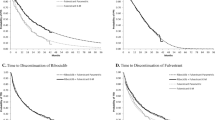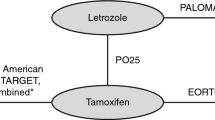Abstract
Therapy decisions in advanced breast cancer (ABC) increasingly require assessment not only of treatment efficacy but also of cost-effectiveness. To this end, we performed a cost-utility analysis by comparing treatment sequences including/omitting fulvestrant in a hypothetical population of hormone receptor-positive (HR+) postmenopausal women with ABC. The analysis was performed from the German health care perspective. Using a first-order sequential Markov model, expected costs and utilities were calculated over a time horizon of 10 years for cohorts of patients with HR+ ABC, previously treated for at least 5 years using adjuvant endocrine therapies. Utilities were primarily quantified in terms of quality adjusted life years (QALY). “Base-case” estimates of state transition rates, resource utilization, and other model parameters were derived from published evidence and expert assessment. The impacts of uncertainties in all key model parameters were evaluated by sensitivity analysis. Costs and benefits were discounted at 3% annually. Including second-line fulvestrant in the treatment sequence led to greater estimated health gains (0.021 QALY) and cost savings of €564 ($745, £380) per patient, i.e. the fulvestrant-containing sequence was “dominant”. The prediction of a cost savings was robust with respect to variations in all key parameters. The probability of acceptable cost-effectiveness for the fulvestrant sequence was 72% at a willingness to pay (WTP) of €30,000/QALY ($39,621/QALY, £20,198/QALY); the probability was even higher at lower WTP and substantially exceeded 50% for any realistic WTP. In a representative population of women with HR+ advanced breast cancer, inclusion of fulvestrant in the treatment sequence provides a cost-effective alternative from the German health care perspective. A high probability of cost-effectiveness is maintained under variations in all key parameters. The results reflect a tendency for patients receiving fulvestrant at an early stage to maintain high quality of life for a longer interval.





Similar content being viewed by others
Notes
Data on file. Utilities from Belgian clinicians were obtained from a panel of five Belgian clinicians as part of a health economic analysis for fulvestrant in the Belgian health care system. The analysis was part of an official application for reimbursement of fulvestrant by AstraZeneca Belgium to the Belgian reimbursement authority (CTG = Commissie Tegemoetkoming Geneesmiddelen, CRM = Commission de Remboursement des Médicaments The application was submitted on March 12, 2007) 2007.
References
Porzsolt F, Klinische Ökonomik (2003) Die ökonomische Bewertung von Gesundheitsleistungen aus der Sicht des Patienten. In: Porzsolt F, Williams AR, Kaplan RM, Klinische Ökonomik (eds) Effektivität und Effizienz von Gesundheitsleistungen. Ecomed, Landsberg, pp 17–40
Health and Health Care 2010 (2000) The forecast, the challenge by the Institute for the Future. Jossey-Bass, San Francisco, CA, ISBN 0-7879-5348-2
National Institute for Clinical Excellence (NICE) (2008) http://www.nice.org.uk
Institut für Qualität und Wirtschaftlichkeit im Gesundheitswesen (IQWiG) (2008) http://www.iqwig.de/index.2.en.html
Federal Ministry of Health (Bundesgesundheitsministerium, BMG FHM (2008) http://www.bmg.bund.de/cln_041/DE/Home/homepage_node.html_nnn=true
Beslija S, Bonneterre J, Burstein H, Cocquyt V, Gnant M, Goodwin P et al (2007) Second consensus on medical treatment of metastatic breast cancer. Ann Oncol 18(2):215–225
AGO Guideline (2008) http://www.ago-online.de/index/php?lang=de&sote=mamma_guide08_1_1&topic=mamma_guide
Simons WR, Jones D, Buzdar A (2003) Cost-effectiveness of anastrozole versus tamoxifen as first-line therapy for postmenopausal women with advanced breast cancer. Clin Ther 25(11):2972–2985
Schackman BR, Gold HT, Stone PW, Neumann PJ (2004) How often do sensitivity analyses for economic parameters change cost-utility analysis conclusions? Pharmacoeconomics 22(5):293–300
Briggs A, Sculpher M (1998) An introduction to Markov modelling for economic evaluation. Pharmacoeconomics 13(4):397–409
Sonnenberg FA, Beck JR (1993) Markov models in medical decision making: a practical guide. Med Decis Making 13:322–338
DerSimonian R, Laird N (1986) Meta-analysis in clinical trials. Control Clin Trials 7(3):177–188
Rose C, Vtoraya O, Pluzanska A, Davidson N, Gershanovich M, Thomas R et al (2003) An open randomised trial of second-line endocrine therapy in advanced breast cancer comparison of the aromatase inhibitors letrozole and anastrozole. Eur J Cancer 39(16):2318–2327
Nabholtz JM, Falkson C, Campos D, Szanto J, Martin M, Chan S et al (2003) Docetaxel and doxorubicin compared with doxorubicin and cyclophosphamide as first-line chemotherapy for metastatic breast cancer: results of a randomized, multicenter, phase III trial. J Clin Oncol 21(6):968–975
Chia S, Gradishar W, Mauriac L, Bines J, Amant F, Federico M, Fein L, Romieu G, Buzdar A, Robertson JF, Brufsky A, Possinger K, Rennie P, Sapunar F, Lowe E, Piccart M (2008) Double-blind, randomized placebo controlled trial of fulvestrant compared with exemestane after prior nonsteroidal aromatase inhibitor therapy in postmenopausal women with hormone receptor-positive, advanced breast cancer: results from EFECT. J Clin Oncol 26(10):1664–1670
Lønning PE, Bajetta E, Murray R, Tubiana-Hulin M, Eisenberg PD, Mickiewicz E, Celio L, Pitt P, Mita M, Aaronson NK, Fowst C, Arkhipov A, di Salle E, Polli A, Massimini G (2000) Activity of exemestane in metastatic breast cancer after failure of nonsteroidal aromatase inhibitors: a phase II trial. J Clin Oncol 18(11):2234–2244
Thurlimann B, Hess D, Koberle D, Senn I, Ballabeni P, Pagani O et al (2004) Anastrozole (‘Arimidex’) versus tamoxifen as first-line therapy in postmenopausal women with advanced breast cancer: results of the double-blind cross-over SAKK trial 21/95—a sub-study of the TARGET (Tamoxifen or ‘Arimidex’ Randomized Group Efficacy and Tolerability). Breast Cancer Res Treat 85(3):247–254
Buzdar A, Hayes D, El-Khoudary A, Yan S, Lønning P, Lichinitser M et al (2001) Phase III, multicenter, double-blind, randomized study of letrozole, an aromatase inhibitor, for advanced breast cancer. Am Soc Clin Oncol 19:3357–3366
Tominaga T, Adachi I, Sasaki Y, Tabei T, Ikeda T, Takatsuka Y et al (2002) Double-blind randomised trial comparing the non-steroidal aromatase inhibitors letrozole and fadrozole in postmenopausal women with advanced breast cancer. Ann Oncol 14:62–70
Robertson JF, Osborne CK, Howell A, Jones SE, Mauriac L, Ellis M et al (2003) Fulvestrant versus anastrozole for the treatment of advanced breast carcinoma in postmenopausal women: a prospective combined analysis of two multicenter trials. Cancer 98(2):229–238
Howell A, Robertson JF, Quaresma AJ, Aschermannova A, Mauriac L, Kleeberg UR et al (2002) Fulvestrant, formerly ICI 182, 780, is as effective as anastrozole in postmenopausal women with advanced breast cancer progressing after prior endocrine treatment. J Clin Oncol 20(16):3396–3403
Osborne CK, Pippen J, Jones SE, Parker LM, Ellis M, Come S et al (2002) Double-blind, randomized trial comparing the efficacy and tolerability of fulvestrant versus anastrozole in postmenopausal women with advanced breast cancer progressing on prior endocrine therapy: results of a North American trial. J Clin Oncol 20(16):3386–3395
Buzdar A, Jonat W, Howell A, Jones SE, Blomqvist CP, Vogel CL et al (1998) Anastrozole versus megestrol acetate in the treatment of postmenopausal women with advanced breast carcinoma. Am Cancer Soc 83:1142–1152
Buzdar A, Jones SE, Vogel CL, Wolter J, Plourde P, Webster A (1997) A phase III trial comparing anastrozole (1 and 10 milligrams), a potent and selective aromatase inhibitor, with megestrol acetate in postmenopausal women with advanced breast carcinoma. Am Cancer Soc 79:730–739
Ingle JN, Suman VJ, Rowland KM, Mirchandani D, Bernath AM, Camoriano JK et al (2006) Fulvestrant in women with advanced breast cancer after progression on prior aromatase inhibitor therapy: North Central Cancer Treatment Group Trial N0032. J Clin Oncol 24(7):1052–1056
O’Shaughnessy J, Miles D, Vukelja S, Moiseyenko V, Ayoub JP, Cervantes G et al (2002) Superior survival with capecitabine plus docetaxel combination therapy in anthracycline-pretreated patients with advanced breast cancer: phase III trial results. J Clin Oncol 20(12):2812–2823
Blum JL, Dieras V, Lo Russo PM, Horton J, Rutman O, Buzdar A et al (2001) Multicenter, Phase II study of capecitabine in taxane-pretreated metastatic breast carcinoma patients. Cancer 92(7):1759–1768
ROTE LISTE® (2007) German drug list (including EU approvals and specific medicinal products). www.rote-liste.de/
Einheitlicher Bewertungsmaßstab (2007) http://www.ebm2000plus.d
Albert U-S et al (2008) Stufe-3-Leitlinie Brustkrebs-Früherkennung in Deutschland. 1. Aktualisierung 2008. W Zuckschwerdt Verlag, München
Gold MR (1996) Cost-effectiveness in health and medicine. Oxford University Press, New York
Cameron DA, Camidge DR, Gait CF, Hirsch M (2006) Fulvestrant in the treatment of hormone receptor-positive advanced breast cancer—a cost-effective addition to the treatment sequence. Breast Cancer Res Treat 100(Supplement 1, S231)
Drummond MF et al (2005) Methods for the economic evaluation of health care programmes. Cost-effectiveness analysis, 3rd edn. OUP, Oxford, pp 103–136
Uyl-de Groot CA (2006) Economic evaluation of cancer therapies: more and better studies will lead to better choices in cancer care. Eur J Cancer 42(17):2862–2866
Arbeitsgemeinschaft Bevölkerungsbezogener Krebsregister (2008) http://www.krebsgesellschaft.de/krebsregister,11268.html
Howell A, Robertson JF, Abram P, Lichinitser MR, Elledge R, Bajetta E et al (2004) Comparison of fulvestrant versus tamoxifen for the treatment of advanced breast cancer in postmenopausal women previously untreated with endocrine therapy: a multinational, double-blind, randomized trial. J Clin Oncol 22(9):1605–1613
Howell A, Pippen J, Elledge RM, Mauriac L, Vergote I, Jones SE et al (2005) Fulvestrant versus anastrozole for the treatment of advanced breast carcinoma: a prospectively planned combined survival analysis of two multicenter trials. Cancer 104(2):236–239
Howell A (2007) Development of endocrine therapy of breast cancer 1896–2006. Geburtshilfe Frauenheilkd 67:595–601
DeFriend DJ, Howell A, Nicholson RI, Anderson E, Dowsett M, Mansel RE et al (1994) Investigation of a new pure antiestrogen (ICI 182780) in women with primary breast cancer. Cancer Res 54(2):408–414
Howell A (1996) New endocrine treatment strategies. Eur J Cancer 5(3):2
Warm M, Kates R, Overkamp F, Zaun SG, Harbeck N (2009) Results of the German fulvestrant in practice evaluation programme to evaluate the efficacy, safety, tolerability and acceptance of fulvestrant under daily routine conditions. Cancer Res 69(Suppl):399s
Cameron DA, Camidge DR, Gait CF, Hirsch M (2006) Fulvestrant in the treatment of hormone receptor-positive advanced breast cancer—a cost-effective addition to the treatment sequence. 29th Annual San Antonio breast cancer symposium, San Antonio, Texas, 14th–17th December 2006
Acknowledgements
The authors would like to thank Dr. Ronald Kates for his professional editing, helpful comments and perceptive criticisms of the manuscript. This work was supported by an unrestricted grant from AstraZeneca Germany.
Author information
Authors and Affiliations
Corresponding author
Electronic supplementary material
Rights and permissions
About this article
Cite this article
Lux, M.P., Hartmann, M., Jackisch, C. et al. Cost-utility analysis for advanced breast cancer therapy in Germany: results of the fulvestrant sequencing model. Breast Cancer Res Treat 117, 305–317 (2009). https://doi.org/10.1007/s10549-008-0294-9
Received:
Accepted:
Published:
Issue Date:
DOI: https://doi.org/10.1007/s10549-008-0294-9




